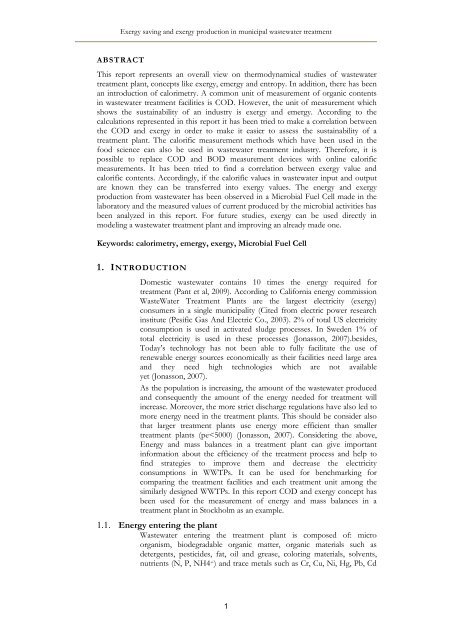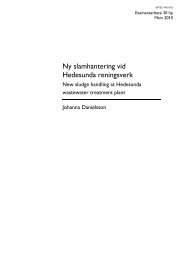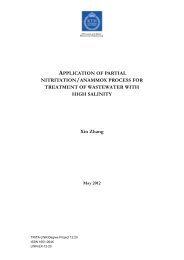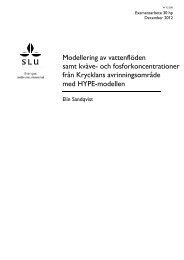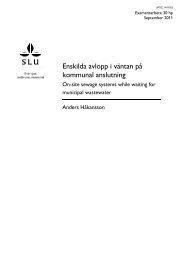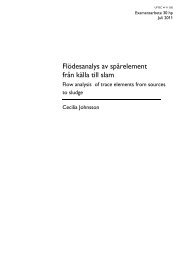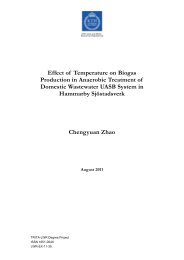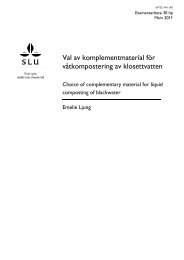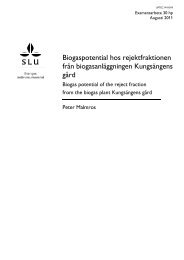Exergy saving and exergy production in municipal wastewater ...
Exergy saving and exergy production in municipal wastewater ...
Exergy saving and exergy production in municipal wastewater ...
Create successful ePaper yourself
Turn your PDF publications into a flip-book with our unique Google optimized e-Paper software.
<strong>Exergy</strong> <strong>sav<strong>in</strong>g</strong> <strong>and</strong> <strong>exergy</strong> <strong>production</strong> <strong>in</strong> <strong>municipal</strong> <strong>wastewater</strong> treatment<br />
ABSTRACT<br />
This report represents an overall view on thermodynamical studies of <strong>wastewater</strong><br />
treatment plant, concepts like <strong>exergy</strong>, emergy <strong>and</strong> entropy. In addition, there has been<br />
an <strong>in</strong>troduction of calorimetry. A common unit of measurement of organic contents<br />
<strong>in</strong> <strong>wastewater</strong> treatment facilities is COD. However, the unit of measurement which<br />
shows the susta<strong>in</strong>ability of an <strong>in</strong>dustry is <strong>exergy</strong> <strong>and</strong> emergy. Accord<strong>in</strong>g to the<br />
calculations represented <strong>in</strong> this report it has been tried to make a correlation between<br />
the COD <strong>and</strong> <strong>exergy</strong> <strong>in</strong> order to make it easier to assess the susta<strong>in</strong>ability of a<br />
treatment plant. The calorific measurement methods which have been used <strong>in</strong> the<br />
food science can also be used <strong>in</strong> <strong>wastewater</strong> treatment <strong>in</strong>dustry. Therefore, it is<br />
possible to replace COD <strong>and</strong> BOD measurement devices with onl<strong>in</strong>e calorific<br />
measurements. It has been tried to f<strong>in</strong>d a correlation between <strong>exergy</strong> value <strong>and</strong><br />
calorific contents. Accord<strong>in</strong>gly, if the calorific values <strong>in</strong> <strong>wastewater</strong> <strong>in</strong>put <strong>and</strong> output<br />
are known they can be transferred <strong>in</strong>to <strong>exergy</strong> values. The energy <strong>and</strong> <strong>exergy</strong><br />
<strong>production</strong> from <strong>wastewater</strong> has been observed <strong>in</strong> a Microbial Fuel Cell made <strong>in</strong> the<br />
laboratory <strong>and</strong> the measured values of current produced by the microbial activities has<br />
been analyzed <strong>in</strong> this report. For future studies, <strong>exergy</strong> can be used directly <strong>in</strong><br />
model<strong>in</strong>g a <strong>wastewater</strong> treatment plant <strong>and</strong> improv<strong>in</strong>g an already made one.<br />
Keywords: calorimetry, emergy, <strong>exergy</strong>, Microbial Fuel Cell<br />
1. INTRODUCTION<br />
Domestic <strong>wastewater</strong> conta<strong>in</strong>s 10 times the energy required for<br />
treatment (Pant et al, 2009). Accord<strong>in</strong>g to California energy commission<br />
WasteWater Treatment Plants are the largest electricity (<strong>exergy</strong>)<br />
consumers <strong>in</strong> a s<strong>in</strong>gle <strong>municipal</strong>ity (Cited from electric power research<br />
<strong>in</strong>stitute (Pesific Gas And Electric Co., 2003). 2% of total US electricity<br />
consumption is used <strong>in</strong> activated sludge processes. In Sweden 1% of<br />
total electricity is used <strong>in</strong> these processes (Jonasson, 2007).besides,<br />
Today’s technology has not been able to fully facilitate the use of<br />
renewable energy sources economically as their facilities need large area<br />
<strong>and</strong> they need high technologies which are not available<br />
yet (Jonasson, 2007).<br />
As the population is <strong>in</strong>creas<strong>in</strong>g, the amount of the <strong>wastewater</strong> produced<br />
<strong>and</strong> consequently the amount of the energy needed for treatment will<br />
<strong>in</strong>crease. Moreover, the more strict discharge regulations have also led to<br />
more energy need <strong>in</strong> the treatment plants. This should be consider also<br />
that larger treatment plants use energy more efficient than smaller<br />
treatment plants (pe


